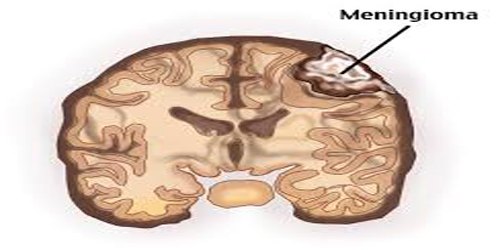Meningioma is a tumor that arises from meninges – the membranes that surround your brain and spinal cord. Symptoms depend on the location and occur as a result of pressing the tumor on nearby tissues. In many cases, the symptoms never form. Occasionally there may be convulsions, dementia, speech problems, vision problems, unilateral weakness, or loss of bladder control. They will often become quite large before diagnosis. Although they are usually benign (not cancerous), they can still be as big as life-threatening. Tumors that cause cancer are called malignant. Some patients may have multiple meningiomas. Although not technically a brain tumor, it is included in this section because it can compress or excrete adjacent brain, nerves, and vessels. Meningoma is the most common type of tumor that occurs in the head.
Risk factors include exposure to ionizing radiation such as: during radiation therapy, family history of the condition, and neurofibromatosis type 2. As of 2014, they don’t seem to be related to cell phone use. Normal-pressure inside the head, resulting in headache, nausea, and vomiting. Some meningiomas contain cyst or calcified minerals and others contain hundreds of tiny blood vessels. As meningiomas grow inward, they usually put pressure on the brain or spinal cord. They can also grow on the outside, making the skull thicker (hyperostosis). They seem to be able to form from a variety of cells, including arachnoid cells. Diagnosis is usually made by medical imaging. These are the most common primary brain tumors in adults. Most meningiomas (85-90 percent) are classified as benign tumors, with the remaining 10-15 percent being atypical or malignant (cancer).
If there are no symptoms, there may be everything necessary for phase monitoring. Most of the symptoms can be treated surgically. After complete removal, less than 20% will repeat the number. The term “gentle” for meningiomas can be confusing. Depending on the location and the rate of growth, benign meningomas can force on important nerves or compress the brain, leading to disability. They can even be fatal. Meningococcus is more common in women and is most often discovered in old age but can occur at any age. If surgery is not possible or not all tumors can be removed, radiosurgery may be helpful. Chemotherapy was not found to be useful. A small percentage grows rapidly and is associated with poor results. Even if the tumor is completely removed during surgery, some healthcare providers may recommend radiation therapy to prevent further meningioma development in the future. There is a tendency for meningiomas to grow after surgery.
One in a thousand people in the United States are currently affected. The onset is usually in the elderly. In this group, they present about 30% of brain tumors. Meningomas are more common in women between 40 and 70 years of age. These are found in about 3 percent of people over the age of 60. Meningomas was reported by Felix Platter in early 1614.














